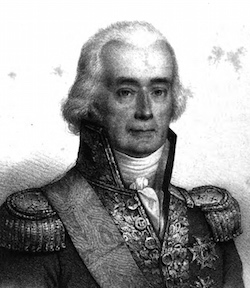Admiral Pierre-César-Charles-Guillaume de Sercey

Born: April 26, 1753
Place of Birth: Comelle-sous-Beuvray, Saône-et-Loire, France
Died: August 10, 1836
Place of Death: Paris, France
Arc de Triomphe: SERCEY on the west pillar
Pronunciation:
Volunteering to serve on a ship at age thirteen in 1766, Pierre-César-Charles-Guillaume de Sercey embarked at Brest for a life at sea. After serving in the Antilles and then the Indian Ocean, he was named a garde de la marine in 1770. Next Sercey served in the Indies and then he served aboard an expedition for the Australian seas on the ship Gros Ventre before returning to France in 1774. The following year he again set sail for Antilles and only returned to Brest in 1778. Sercey was then sent to Plouescat to bring the frigate Belle Poule to Brest and then in 1779 he was promoted to ensign of vessel.
As the French became involved in the American Revolutionary War, Sercey served aboard the ships Triton, Couronne, Ville de Paris, the frigate Concorde, and then he took command of the cutter Sans Pareil. He served under Admiral de Guichen in the Antilles and took part in the combats of April 17th and May 19th of 1780. On June 26th Sercey was taken prisoner by the British but he was then exchanged in October. Sercey was then given command of the cutter Serpent and then Levrette and he served at the Siege of Pensacola. In May of 1781 he was promoted to lieutenant of vessel and a year later he was recognized as a Knight of Saint Louis. Sercey then set sail with the frigate Nymphe for the West Indies and Nymphe captured two slave trader ships in December of 1782. In January of 1783 the Nymphe alongside the Concorde retook the former French ship Cérès that had been captured by the British. The next month Nymphe joined up with Amphitrite and entered into battle with HMS Argo which was carrying the British governor of the Leeward Isles. When the captain of the Nymphe was wounded, Sercey took over command. After several hours of battle the French ships emerged victorious when the Argo surrendered. After the conclusion of the war, Sercey commanded the frigate Ariel in the Antilles.
After the onset of the Revolution, Sercey was commanding the frigate Surveillante at Martinique. He was promoted to captain of vessel in 1792 and he served at Saint-Domingue and then in 1793 he was promoted to rear admiral. Sercey next set sail from Brest for Saint-Domingue to escort the merchant ships to France, only to find the colony of Saint-Domingue in full revolt. He collected the colonists of Cap Haïten on his ships and set sail for the United States before then returning to France in November of 1793. After he had returned, he was relieved of command as a noble and then imprisoned at the Luxembourg.
In January of 1795, well after the Thermidorian Reaction had overthrown Robespierre and ended the Reign of Terror, Sercey was released from prison and reintegrated in the navy as a rear admiral. That November he took command of the squadron destined for Île de France that was tasked with fighting the British in the Indian Ocean. He and his squadron left Brest in March of 1796. They arrived in June but the locals refused to allow his commissaries to disembark and Sercey therefore set sail again. On September 9, 1796 Sercey's squadron encountered two British ships, HMS Arrogant and HMS Victorious at the Strait of Malacca and they entered battle with the French emerging victorious as the British retreated. Sercey's squadron sailed on for Batavia, also known as the Dutch East Indies, before returning to Île-de-France in early 1797. He and his squadron next returned to France and then sailed back to Batavia. Slowly losing ships to repairs and other theaters, Sercey continued to try and battle the British navy in the Indian Ocean, but his efforts grew more difficult. He lost his last ship Preneuse defending Port-Louis in December of 1800 and afterwards the ship was set fire by British Admiral Hotham.
Sercey returned to France after the peace of Amiens, but he quickly ran into trouble with Minister of Marine Dècres over Sercey's conduct in the Indian Ocean. Sercey asked for and obtained retirement in 1804 and he returned to Île-de-France as a civilian. When the island was attacked by the British in 1810, he took part in the defense. Afterwards he returned to France where he took no part in the remainder of the ongoing wars. After Napoleon's abdication and the Bourbon Restoration, Sercey returned to the navy and was promoted to vice admiral.
Bibliography
Related Pages:
Updated January 2017
© Nathan D. Jensen